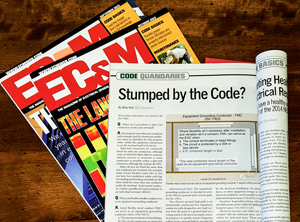|
Q1. What does the NEC mean by “Readily Accessible”?
A1. Accessible, Readily (Readily Accessible). Capable of being reached quickly for operation, renewal or inspections without requiring those to whom ready access is requisite to take actions such as the use tools (other than keys), to climb over or under, remove obstacles, or resort to portable ladders, and so forth [Article 100].
Note: Use of keys is a common practice under controlled or supervised conditions.
Q2. What is the Code definition of “Building”?
A2. Building. A structure that stands alone or is separated from adjoining structures by fire walls [Article 100].
Q3. Does the Code have service equipment fault current labeling requirements for services rated 1,200 amps and more?
A3. Service Equipment Available Fault Current Label. Service equipment rated 1,200A or more must have a field or factory installed label containing the following details and have sufficient durability to withstand the environment [110.16(B)]:
(1) Nominal system voltage
(2) Available fault current at the service overcurrent protection device
(3) Clearing time of the service overcurrent protection device based on the available fault current at the service equipment
(4) Date the service equipment available fault current label was installed
Ex: Service equipment labeling isn’t required if an arc flash label in accordance with NFPA 70E, Standard for Electrical Safety in the Workplace [see Note 3] is applied.
Note 1: NFPA 70E, Standard for Electrical Safety in the Workplace, provides guidance in determining the severity of potential exposure, planning safe work practices, arc flash labeling, and selecting personal protective equipment.
Note No. 3: NFPA 70E, Standard for Electrical Safety in the Workplace provides specific criteria for developing arc flash labels, such as nominal system voltage, incident energy levels, arc flash boundaries, and selecting personal protective equipment.
Q4. What does the Code require for the identification of branch circuit conductors?
A4. Section 210.5 lists the following requirements:
(A) Neutral Conductor. The neutral conductor of a branch circuit must be identified in accordance with 200.6.
(B) Equipment Grounding Conductor. Equipment grounding conductors can be bare, covered, or insulated. Insulated equipment grounding conductors size 6 AWG and smaller must have a continuous outer finish either green or green with one or more yellow stripes [250.119].
On equipment grounding conductors 4 AWG and larger, insulation can be permanently reidentified with green marking at the time of installation at every point where the conductor is accessible [250.119(A)].
(C) Identification of Ungrounded Conductors. Ungrounded circuit conductors must be identified as follows:
(1) More Than One Voltage System. Where the premises wiring system has branch circuits supplied from more than one nominal voltage system, each ungrounded conductor must be identified by phase and system at all termination, connection, and splice points as follows:
(a) Means of Identification. Identification can be by color coding, marking tape, tagging, or other means approved by the authority having jurisdiction.
(b) Posting of Branch Circuit Identification. The method of identification must be readily available or permanently posted at each branch circuit panelboard, not be handwritten, and be of sufficient durability to withstand the environment involved.
Ex: Where a different voltage system is added to an existing installation, branch circuit identification is required for the new voltage system. Existing unidentified systems aren’t required to be identified at each termination, connection, and splice point in compliance with 210.5(C)(1)(a) and (b). Each voltage system distribution equipment must have a label with the words “other unidentified systems exist on the premises.”
Author’s Comment:
- When a premises has more than one voltage system supplying branch circuits, the ungrounded conductors must be identified by phase and system. This can be done by permanently posting an identification legend that describes the method used, such as color coded marking tape or color
coded insulation.
- Conductors with insulation that’s green or green with one or more yellow stripes can’t be used for an ungrounded or neutral conductor [250.119].
- Although the NEC doesn’t require a specific color code for ungrounded conductors, electricians often use the following color system for power and lighting conductor identification:
• 120/240V, single phase—black, red, and white
• 120/208V, three phase—black, red, blue, and white
• 120/240V, three phase—black, orange, blue, and white
• 277/480V, three phase—brown, orange, yellow, and gray; or, brown, purple, yellow, and gray
|


